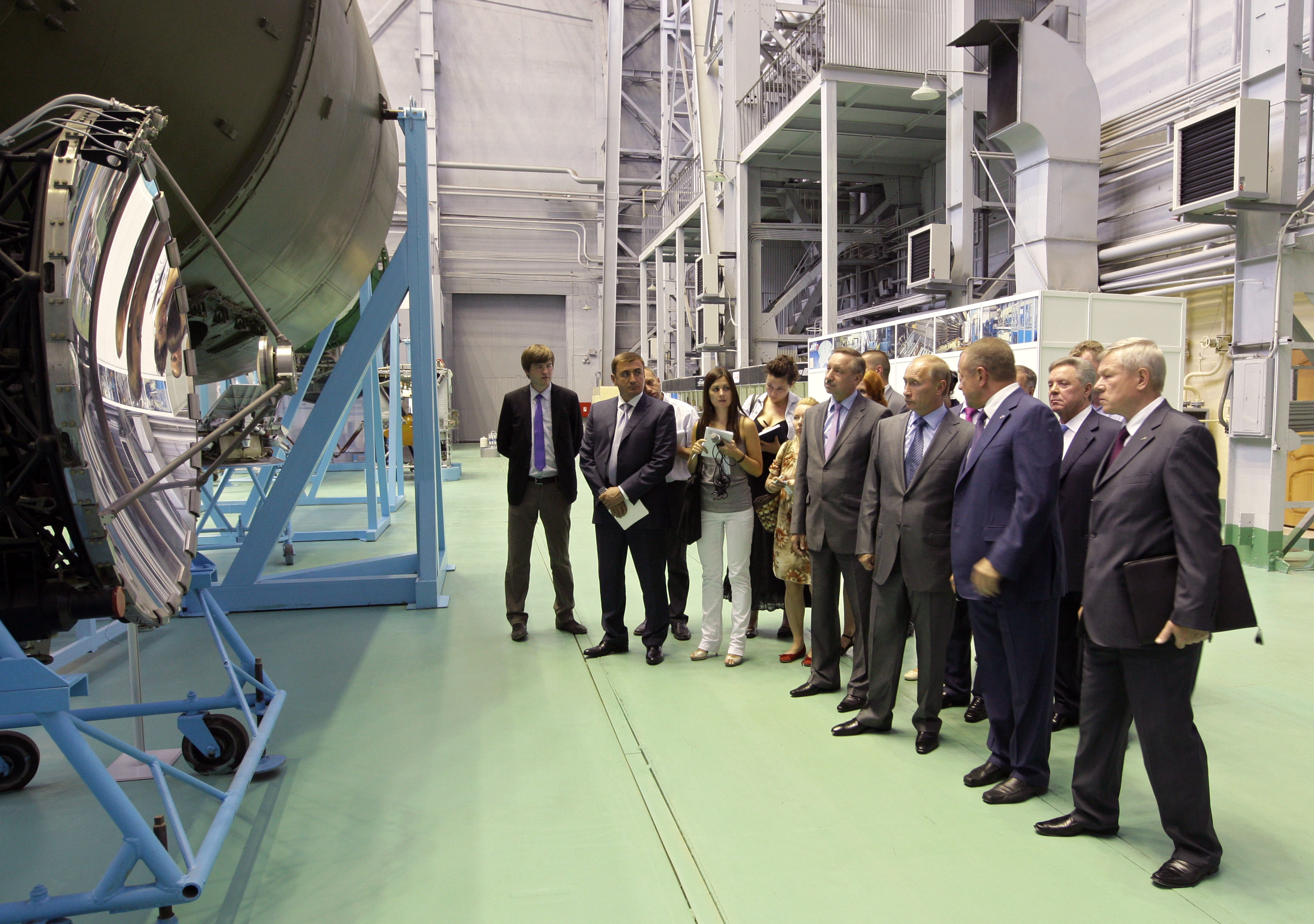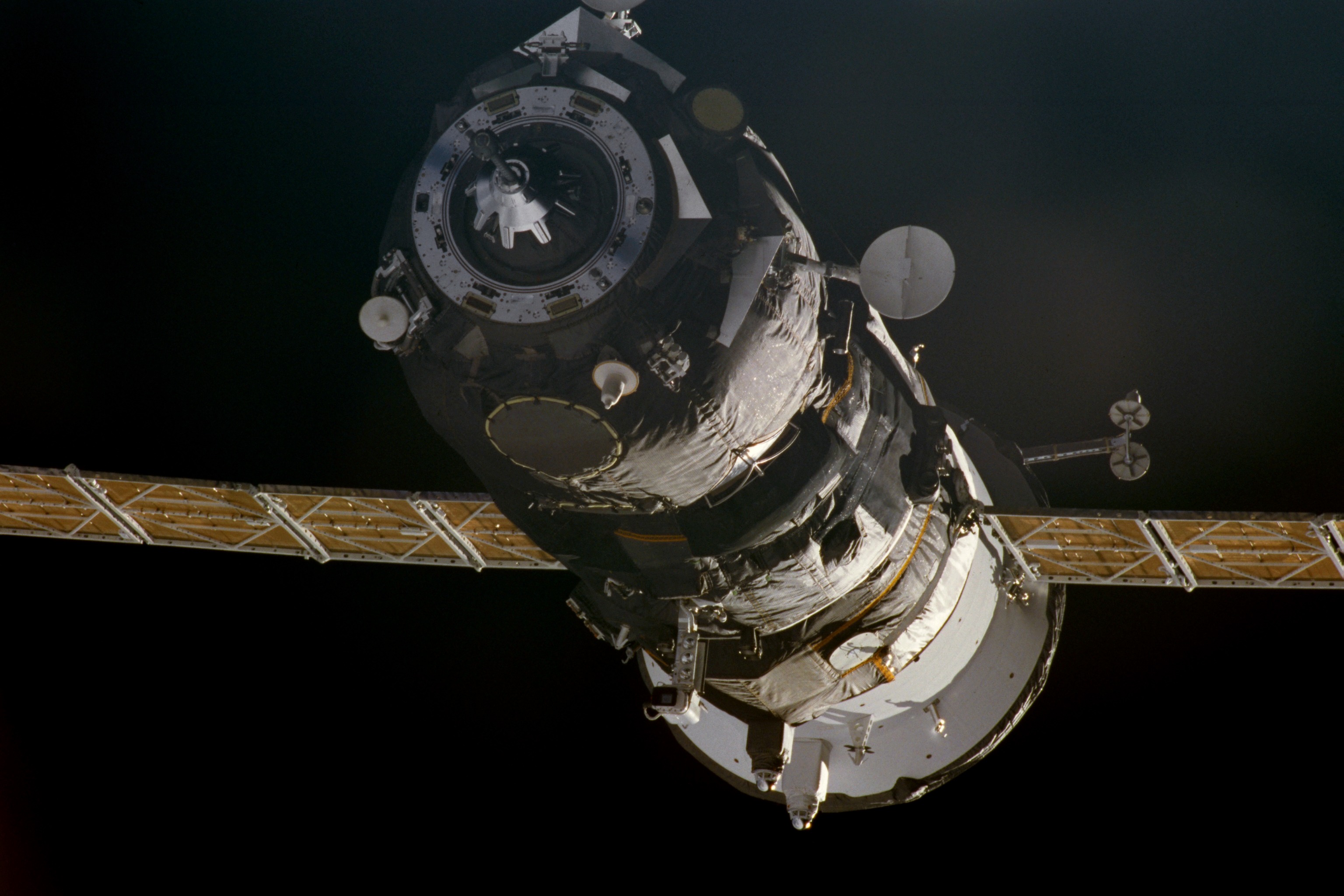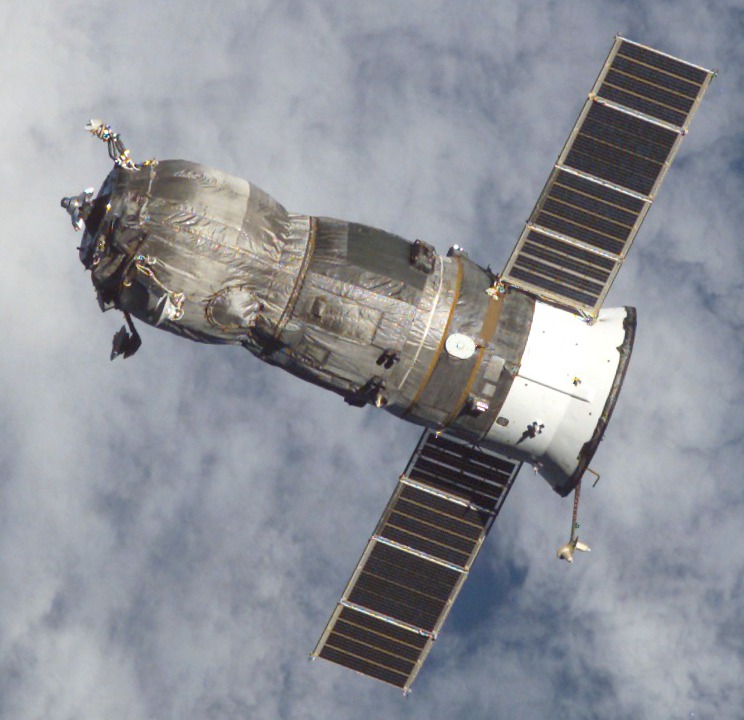|
Progress Spacecraft
The Progress () is a Russian expendable cargo spacecraft. Originally developed for the Soviet space program and derived from the crewed Soyuz spacecraft, Progress has been instrumental in maintaining long-duration space missions by providing consumables like food, water, and air, as well as maintenance equipment. Since its maiden flight in 1978, Progress has supported various space stations, including Salyut 6, Salyut 7, and Mir, and remains a key resupply vehicle for the International Space Station (ISS). Each Progress mission delivers thousands of kilograms of supplies in its pressurized module. It also carries water, fuel, and gases to replenish the station's resources and sustain its onboard atmosphere. Beyond resupply duties, a docked Progress can maneuver or reboost the station, countering atmospheric drag and maintaining its operational altitude. When a Progress spacecraft nears the end of its design life, it is loaded with waste, undocked, and deorbited to safely dis ... [...More Info...] [...Related Items...] OR: [Wikipedia] [Google] [Baidu] |
Progress MS-11
Progress MS-11 (), identified by NASA as Progress 72P, was a Progress (spacecraft), Progress spaceflight operated by Roscosmos to resupply the International Space Station (ISS). This was the 163rd flight of a Progress spacecraft. History The Progress (spacecraft)#Progress MS (2015–present), Progress-MS is an uncrewed freighter based on the Progress-M featuring improved avionics. This improved variant first launched on 21 December 2015. It has the following improvements: * New external compartment that enables it to deploy satellites. Each compartment can hold up to four launch containers. First time installed on Progress MS-03. * Enhanced redundancy thanks to the addition of a backup system of electrical motors for the docking and sealing mechanism. * Improved Micrometeoroid (MMOD) protection with additional panels in the cargo compartment. * Luch (satellite), Luch Russian Communications satellite, relay satellites link capabilities enable telemetry and control even when no ... [...More Info...] [...Related Items...] OR: [Wikipedia] [Google] [Baidu] |
International Space Station
The International Space Station (ISS) is a large space station that was Assembly of the International Space Station, assembled and is maintained in low Earth orbit by a collaboration of five space agencies and their contractors: NASA (United States), Roscosmos (Russia), European Space Agency, ESA (Europe), JAXA (Japan), and Canadian Space Agency, CSA (Canada). As the largest space station ever constructed, it primarily serves as a platform for conducting scientific experiments in microgravity and studying the space environment. The station is divided into two main sections: the Russian Orbital Segment (ROS), developed by Roscosmos, and the US Orbital Segment (USOS), built by NASA, ESA, JAXA, and CSA. A striking feature of the ISS is the Integrated Truss Structure, which connect the station’s vast system of solar panels and Spacecraft thermal control, radiators to its pressurized modules. These modules support diverse functions, including scientific research, crew habitation, ... [...More Info...] [...Related Items...] OR: [Wikipedia] [Google] [Baidu] |
GRAU
The Main Missile and Artillery Directorate of the Ministry of Defense of the Russian Federation (), commonly referred to by its transliterated acronym GRAU (), is a department of the Russian Ministry of Defense. It is subordinate to the Chief of Armament and Munition of the Russian Armed Forces, a vice-minister of defense. The organization dates back to 1862 when it was established under the name Main Artillery Directorate (, GAU). The "R" from "rockets" was added to the title from 19 November 1960. The GRAU is responsible for assigning GRAU indices to Russian army ammunitions and equipment. As of April 2025, the Chief of the GRAU was Major General Aleksey Volkov. Arsenals Arsenals of the GRAU, according to Kommersant-Vlast in 2005, included the 53rd at Dzerzhinsk, Nizhniy Novogorod Oblast, the 55th in the Sklad-40 microraion at Rzhev, the 60th at Kaluga, the 63rd at Lipetsk, the 75th at Serpukhov south of Moscow, and the 97th at Skolin (all five in the Moscow Milita ... [...More Info...] [...Related Items...] OR: [Wikipedia] [Google] [Baidu] |
Energia (corporation)
S.P. Korolev Rocket and Space Corporation "Energia" () is a Russian manufacturer of spacecraft and space station components. Its name is derived from the Russian word for energy and is also named for Sergei Korolev, Sergei Pavlovich Korolev, the first chief of its design bureau and the driving force behind early Soviet accomplishments in space exploration. Overview Energia is the largest company of the Russian space industry and one of its key players. It is responsible for all operations involving human spaceflight and is the lead developer of the Soyuz (spacecraft), Soyuz and Progress (spacecraft), Progress spacecraft, and the lead developer of the Russian end of the International Space Station (ISS). In the mid-2000s, the company employed 22,000–30,000 people. The enterprise has been awarded 4 Order of Lenin, Orders of Lenin, Order of the October Revolution and Russian Federation President's Message of Thanks. In addition, 14 cosmonauts employed by the company have been ... [...More Info...] [...Related Items...] OR: [Wikipedia] [Google] [Baidu] |
Progress Drawing
Progress is movement towards a perceived refined, improved, or otherwise desired state. It is central to the philosophy of progressivism, which interprets progress as the set of advancements in technology, science, and social organization efficiency – the latter being generally achieved through direct societal action, as in social enterprise or through activism, but being also attainable through natural sociocultural evolution – that progressivism holds all human societies should strive towards. The concept of progress was introduced in the early-19th-century social theories, especially social evolution as described by Auguste Comte and Herbert Spencer. It was present in the Enlightenment's philosophies of history. As a goal, social progress has been advocated by varying realms of political ideologies with different theories on how it is to be achieved. Measuring progress Specific indicators for measuring progress can range from economic data, technical innovations, chan ... [...More Info...] [...Related Items...] OR: [Wikipedia] [Google] [Baidu] |
Prichal (ISS Module)
''Prichal'' (), also known as the Uzlovoy Module (UM, ) is a Russian-built component of the International Space Station (ISS). This spherical module has six docking ports (forward, aft, port, starboard, zenith, and nadir) to provide additional docking ports for Soyuz and Progress spacecraft, as well as potential future modules. ''Prichal'' was launched on 24November 2021, at 13:06:35UTC, atop a Soyuz-2.1b rocket and guided automously into the nadir port of the '' Nauka'' module by a Progress M-UM spacecraft attached to the ''Prichal''s nadir port. Once in place, the Progress spacecraft disconnected for a destructive reentry. As of 2024, the forward, aft, port and starboard docking ports remain covered. ''Prichal'' was initially intended to be an element of the now canceled Orbital Piloted Assembly and Experiment Complex (OPSEK). Description ''Prichal'' is a nodal module that has a pressurized spherical ball-shaped design with six hybrid docking ports. It also has functio ... [...More Info...] [...Related Items...] OR: [Wikipedia] [Google] [Baidu] |
Poisk (ISS Module)
''Poisk '' (), also known as the ''Mini-Research Module 2'' (MRM 2, ), is a docking module of the International Space Station (ISS). Added in 2009, ''Poisk'' was the first major Russian addition to the International Space Station since 2001. ''Poisk'' is overall the same design as the docking module Pirs (ISS module), ''Pirs''. Whereas ''Pirs'' was attached to the nadir ("bottom") port of Zvezda (ISS module), ''Zvezda'' until it was replaced by Nauka_(ISS_module), ''Nauka'', ''Poisk'' is attached to the zenith ("top"); ''Pirs'' was closer to the Earth with the ISS in its usual orientation, with ''Poisk'' on the other side. ''Poisk'' is Russian for ''explore'' or ''search''. ''Poisk'' combines various docking, Extravehicular activity, EVA, and science capabilities. It has two egress hatches for EVAs in addition to the two spacecraft docking ports. Although ''Poisk'' is designated as Mini-Research Module 2, it arrived before Mini-Research Module 1 (''Rassvet (ISS module), Rassvet'' ... [...More Info...] [...Related Items...] OR: [Wikipedia] [Google] [Baidu] |
Pirs (ISS Module)
''Pirs'' ''('', meaning "pier") – also called Stykovochny Otsek 1 (SO-1; , " docking module") and DC-1 (Docking Compartment 1) – was a Russian module on the International Space Station (ISS). ''Pirs'' was launched on 14 September 2001, and was located on the '' Zvezda'' module of the station. It provided the ISS with one docking port for Soyuz and Progress spacecraft, and allowed egress and ingress for spacewalks by cosmonauts using Russian Orlan space suits. ''Pirs'' was docked to ''Zvezda'' for almost 20 years, until 26 July 2021, when it was decommissioned and undocked by Progress MS-16 to make way for the new '' Nauka'' module. Poisk module A second docking compartment, Stykovochniy Otsek 2 (SO-2), was planned with the same design. However, when the Russian segment of the ISS was redesigned in 2001, the new design no longer included the SO-2, and its construction was canceled. After another change of plans the SO-2 module finally evolved into the ''Poisk'' module, ... [...More Info...] [...Related Items...] OR: [Wikipedia] [Google] [Baidu] |
Progress MS
The Progress MS (; GRAU: 11F615A61) is the latest version of the Russian Progress spacecraft series, first launched in 2015. The "MS" stands for "modernized systems," reflecting upgrades primarily focused on the communications and navigation subsystems. An evolution of the Progress M spacecraft, the Soyuz MS features minimal external changes, mainly in the placement of antennas, sensors, and thrusters. It is used by Roscosmos for cargo spaceflight missions. Progress MS-01 conducted its maiden flight on 21 December 2015, heading to the International Space Station (ISS). Design Like all previous variants, the Progress MS spacecraft consists of three distinct sections: * Cargo Section: This pressurized carries supplies for the crew, including maintenance items, prepackaged and fresh food, scientific equipment, and clothing. Its docking drogue, similar to that of the Soyuz, features ducting that enables fuel transfer (described below). * Tanker Section: Replacing the Soyuz's ... [...More Info...] [...Related Items...] OR: [Wikipedia] [Google] [Baidu] |
Progress M1
Progress-M1 (, GRAU indices 11F615A55 and 11F615A70), also known as Progress 7K-TGM1, is a Russian spacecraft which is used to resupply space stations. It is a variant of the Progress spacecraft, derived from the Progress-M, but modified to carry more UDMH and N2O4 propellant for refuelling the International Space Station instead of other cargoes such as water. A Progress M1 11F615A55 spacecraft could carry up to of propellant in eight mid-section refuelling tanks, compared to the that a Progress-M of the same generation could carry. This propellant can be transferred to the Space Station's own propulsion system through fluid connectors in the docking ring, or it can alternatively be used by the Progress' thrusters to boost the station altitude or to change its orientation, or attitude, in space. In addition to propellant, the spacecraft can also carry up to (6 cubic meters volume) of supplies in its forward pressurized cargo module (including a maximum of of compressed air ... [...More Info...] [...Related Items...] OR: [Wikipedia] [Google] [Baidu] |
Progress M
Progress-M (, GRAU index, GRAU indices 11F615A55 and 11F615A60), also known as Progress 7K-TGM, is a Russian, previously Soviet Union, Soviet spacecraft which is used to resupply space stations. It is a variant of the Progress (spacecraft), Progress spacecraft, originally built in the late 1980s as a modernised version of the Progress 7K-TG spacecraft, using new systems developed for the Soyuz-T and Soyuz-TM spacecraft. The 11F61560 variant incorporated further modernisation, with digital flight control systems replacing the earlier analogue ones. The older 11F615A55 spacecraft outlived the newer 11F615A60. The final Progress-M, Progress M-UM, Progress-M-UM, was launched on 24 November 2021. The first forty three Progress-M spacecraft were used to resupply Mir, with subsequent spacecraft flying to the International Space Station. , eighty seven spacecraft have been launched, with sixty seven using the older model, and twenty using the newer version. Launches of the 11F615A60 a ... [...More Info...] [...Related Items...] OR: [Wikipedia] [Google] [Baidu] |
Progress 7K-TG
Progress 7K-TG (, GRAU index 11F615A15), was a Soviet uncrewed spacecraft used to resupply space stations in low Earth orbit. Forty three flew, delivering cargo to Salyut 6, Salyut 7, and Mir. It was the first version of the Progress spacecraft to fly, and spawned later derivatives including the Progress-M which replaced it, and the later Progress-M1. The Progress 7K-TG spacecraft was derived from the crewed Soyuz 7K-T ferry spacecraft, which had been designed for the Salyut programme. The descent module of the Soyuz spacecraft was replaced with a new section designated ''Otsek Komponentov Dozapravki'', or OKD. This contained fuel tanks and pumps used for refuelling the space station that it docked with. Like the Soyuz 7K-T, the Progress was not equipped with solar panels, and instead relied on batteries for power. Early spacecraft had a design life of 33 days, including three in free flight, and the rest docked with a space station. Later spacecraft flew longer missions, wit ... [...More Info...] [...Related Items...] OR: [Wikipedia] [Google] [Baidu] |








